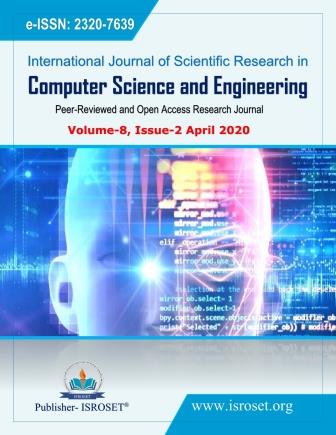Underwater Routing Protocols: Analysis of Intrepid Link Selection Mechanism, Challenges and Strategies
Keywords:
Packet forwarding, relay node, network throughput, underwater routingAbstract
The sensor nodes deployed in underwater environment have a different routing mechanism in contrast to the terrestrial network. In order to get underwater information from dynamically deployed senor nodes, a smooth packet transmission must be maintained, which is a crucial challenge, and selecting the best communication link between source and destination node is a key phenomenon. The meticulous research has been conducted to search out the best link selection mythology of bodacious underwater routing protocol EnOR, SURS‐PES and USPF. The performance has been evaluated through NS2 simulation for packet delivery ratio, end-to-end delay, network lifespan and network energy consumption.
References
Su, Y., Fan, R., Fu, X., & Jin, Z. (2019). DQELR: An Adaptive Deep Q-Network-Based Energy- and Latency-Aware Routing Protocol Design for Underwater Acoustic Sensor Networks. IEEE Access, 7, 9091–9104. doi:10.1109/access.2019.2891590
S, Ashraf, Gao, M., Chen, Z., Kamran, S., & Raza, Z. (2017). Efficient Node Monitoring Mechanism in WSN using Contikimac Protocol. International Journal of Advanced Computer Science and Applications, 8(11). doi:10.14569/ijacsa.2017.081152
Qu, J., Zhang, Z., Cui, Y., Wang, J., & Mastorakis, G. (2019). Research and Application of Multi-Node Communication and Energy Consumption Prediction Control in Underwater Acoustic Network. IEEE Access, 7, 41220–41229. doi:10.1109/access.2019.2907376
Jin, Z., Zhao, Q., & Luo, Y. (2020). Routing Void Prediction and Repairing in AUV-Assisted Underwater Acoustic Sensor Networks. IEEE Access doi:10.1109/access.2020.2980043
Tilwari, V., Maheswar, R., Jayarajan, P., Sundararajan, T. V. P., Hindia, M. N., Dimyati, K., Amiri, I. S. (2020). MCLMR: A Multicriteria Based Multipath Routing in the Mobile Ad Hoc Networks. Wireless Personal Communications. doi:10.1007/s11277-020-07159-8
Somani, Arun K., et al. Smart Systems and IoT: Innovations in Computing: Proceeding of SSIC 2019. Springer, 2020.
Coutinho, R. W. L., Boukerche, A., Vieira, L. F. M., & Loureiro, A. A. F. (2018). Underwater Wireless Sensor Networks. ACM Computing Surveys, 51(1), 1–36. doi:10.1145/3154834
Dubey, A., & Rajawat, A. (2016). Impulse effect of node mobility on delay sensitive routing algorithm in underwater sensor network. 2016 International Conference on Internet of Things and Applications (IOTA. doi:10.1109/iota.2016.7562768
Qian, L., Zhang, S., Liu, M., & Zhang, Q. (2016). A MACA-based power control MAC protocol for Underwater Wireless Sensor Networks. 2016 IEEE/OES China Ocean Acoustics (COA). doi:10.1109/coa.2016.7535810
Cao, J., Dou, J., & Dong, S. (2015). Balance Transmission Mechanism in Underwater Acoustic Sensor Networks. International Journal of Distributed Sensor Networks, 11(3), 429340. doi:10.1155/2015/429340
Suparti Koul, & Harmanjot Kour. (2016). Power Efficient Routing in Wireless Sensor Networks. Unpublished. doi:10.13140/RG.2.2.13755.67363
Balsamo, S., Marin, A., & Vicario, E. (Eds.). (2018). New Frontiers in Quantitative Methods in Informatics. Communications in Computer and Information Science. Springer International Publishing. doi:10.1007/978-3-319-91632-3
Balas, Valentina Emilia., et al. Data Management, Analytics and Innovation: Proceedings of ICDMAI 2018, Volume 1. Springer Singapore, 2019.
Liu, X., Liu, P., Long, T., Lv, Z., & Tang, R. (2018). An efficient depth-based forwarding protocol for underwater wireless sensor networks. 2018 IEEE 3rd International Conference on Cloud Computing and Big Data Analysis doi:10.1109/icccbda.2018.8386561
Ali, M., Khan, A., Mahmood, H., & Bhatti, N. (2019). Cooperative, reliable, and stability-aware routing for underwater wireless sensor networks. International Journal of Distributed Sensor Networks. doi:10.1177/1550147719854249
Coutinho, R. W. L., Boukerche, A., Vieira, L. F. M., & Loureiro, A. A. F. (2016). Geographic and Opportunistic Routing for Underwater Sensor Networks. IEEE Transactions on Computers, 65(2), 548–561. doi:10.1109/tc.2015.2423677
Ashraf, S., Ahmed, T., Raza, A., & Naeem, H. (2020). Design of Shrewd Underwater Routing Synergy Using Porous Energy Shells. Smart Cities, 3(1), 74–92. doi:10.3390/smartcities3010005
Ashraf, S., Gao, M., Mingchen, Z., Ahmed, T., Raza, A., & Naeem, H. (2020). USPF: Underwater Shrewd Packet Flooding Mechanism through Surrogate Holding Time. Wireless Communications and Mobile Computing, 2020, 1–12.doi:10.1155/2020/9625974
EL-Bakkouchi, A., Bouayad, A., & Bekkali, M. E. (2019). A hop-by-hop Congestion Control Mechanisms in NDN Networks – A Survey. 2019 7th Mediterranean Congress of Telecommunications (CMT). doi:10.1109/cmt.2019.8931405
Kumari, R., & Nand, P. (2018). Performance Analysis for MANETs using certain realistic mobility models NS-2. International Journal of Scientific Research in Computer Science and Engineering, 6(1), 70–77. doi: 10.26438/ijsrcse/v6i1.7077
Downloads
Published
How to Cite
Issue
Section
License

This work is licensed under a Creative Commons Attribution 4.0 International License.
Authors contributing to this journal agree to publish their articles under the Creative Commons Attribution 4.0 International License, allowing third parties to share their work (copy, distribute, transmit) and to adapt it, under the condition that the authors are given credit and that in the event of reuse or distribution, the terms of this license are made clear.







